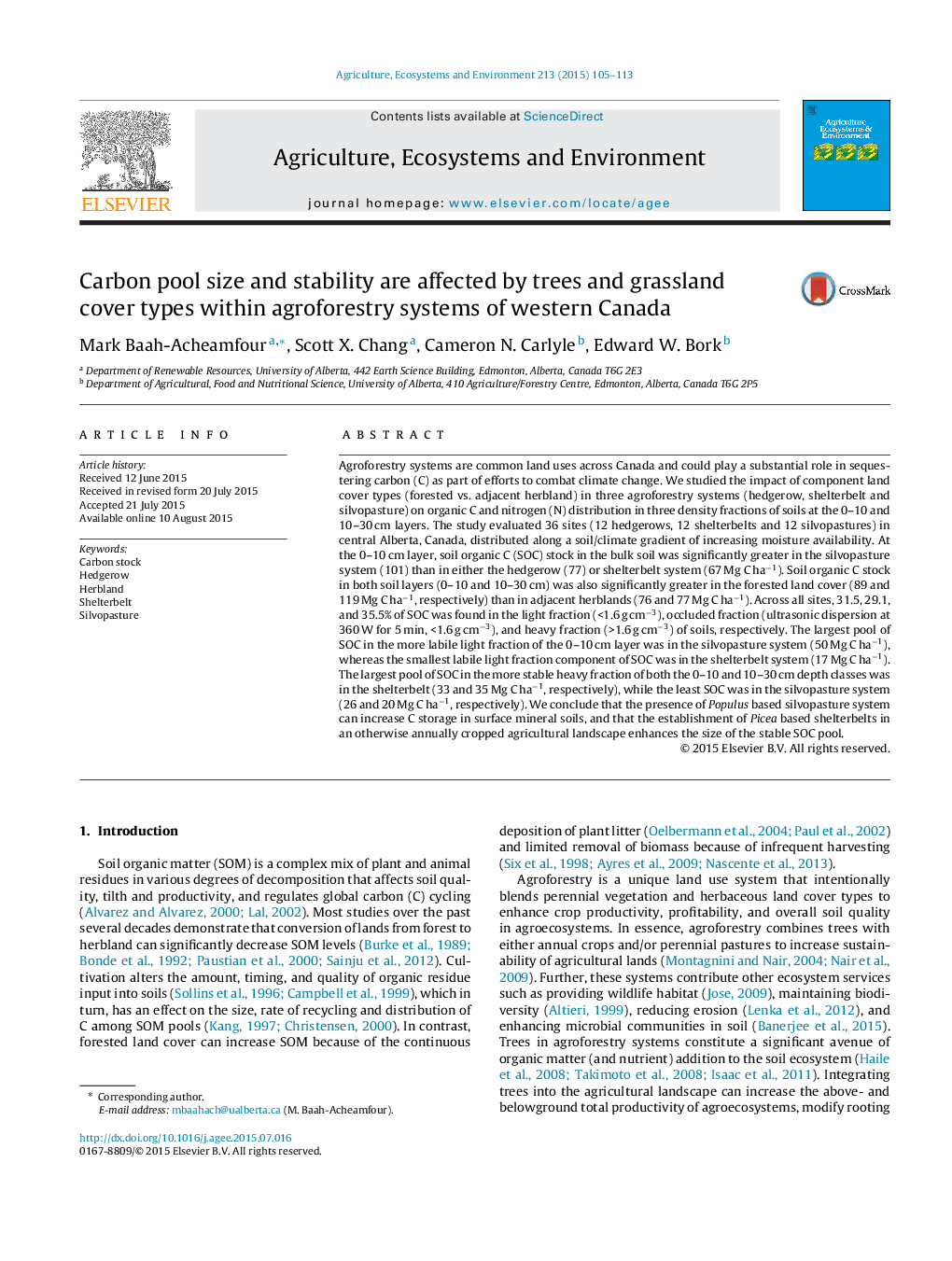| کد مقاله | کد نشریه | سال انتشار | مقاله انگلیسی | نسخه تمام متن |
|---|---|---|---|---|
| 8487579 | 1552039 | 2015 | 9 صفحه PDF | دانلود رایگان |
عنوان انگلیسی مقاله ISI
Carbon pool size and stability are affected by trees and grassland cover types within agroforestry systems of western Canada
ترجمه فارسی عنوان
اندازه و استحکام استخر کربن تحت تاثیر انواع درختان و علفزارها در سیستم های جنگلی کشاورزی غرب کانادا قرار دارد
دانلود مقاله + سفارش ترجمه
دانلود مقاله ISI انگلیسی
رایگان برای ایرانیان
موضوعات مرتبط
علوم زیستی و بیوفناوری
علوم کشاورزی و بیولوژیک
علوم زراعت و اصلاح نباتات
چکیده انگلیسی
Agroforestry systems are common land uses across Canada and could play a substantial role in sequestering carbon (C) as part of efforts to combat climate change. We studied the impact of component land cover types (forested vs. adjacent herbland) in three agroforestry systems (hedgerow, shelterbelt and silvopasture) on organic C and nitrogen (N) distribution in three density fractions of soils at the 0-10 and 10-30 cm layers. The study evaluated 36 sites (12 hedgerows, 12 shelterbelts and 12 silvopastures) in central Alberta, Canada, distributed along a soil/climate gradient of increasing moisture availability. At the 0-10 cm layer, soil organic C (SOC) stock in the bulk soil was significantly greater in the silvopasture system (101) than in either the hedgerow (77) or shelterbelt system (67 Mg C haâ1). Soil organic C stock in both soil layers (0-10 and 10-30 cm) was also significantly greater in the forested land cover (89 and 119 Mg C haâ1, respectively) than in adjacent herblands (76 and 77 Mg C haâ1). Across all sites, 31.5, 29.1, and 35.5% of SOC was found in the light fraction (<1.6 g cmâ3), occluded fraction (ultrasonic dispersion at 360 W for 5 min, <1.6 g cmâ3), and heavy fraction (>1.6 g cmâ3) of soils, respectively. The largest pool of SOC in the more labile light fraction of the 0-10 cm layer was in the silvopasture system (50 Mg C haâ1), whereas the smallest labile light fraction component of SOC was in the shelterbelt system (17 Mg C haâ1). The largest pool of SOC in the more stable heavy fraction of both the 0-10 and 10-30 cm depth classes was in the shelterbelt (33 and 35 Mg C haâ1, respectively), while the least SOC was in the silvopasture system (26 and 20 Mg C haâ1, respectively). We conclude that the presence of Populus based silvopasture system can increase C storage in surface mineral soils, and that the establishment of Picea based shelterbelts in an otherwise annually cropped agricultural landscape enhances the size of the stable SOC pool.
ناشر
Database: Elsevier - ScienceDirect (ساینس دایرکت)
Journal: Agriculture, Ecosystems & Environment - Volume 213, 25 December 2015, Pages 105-113
Journal: Agriculture, Ecosystems & Environment - Volume 213, 25 December 2015, Pages 105-113
نویسندگان
Mark Baah-Acheamfour, Scott X. Chang, Cameron N. Carlyle, Edward W. Bork,
